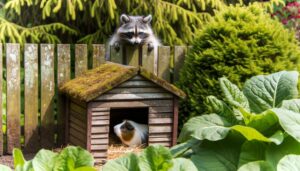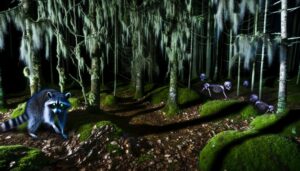What Types of Meat Does a Raccoon Eat?
Yes, raccoons consume meat as part of their omnivorous diet. They typically eat small mammals, insects, amphibians, and carrion.
Raccoon scat analysis confirms a mix of plant and animal sources, indicating dietary balance and adaptability. Their sensitive front paws and nocturnal foraging enhance their ability to hunt and scavenge effectively.
These feeding patterns shift seasonally based on food availability, showing their behavioral plasticity. Additionally, raccoons in urban areas often exploit anthropogenic food sources, demonstrating their opportunistic strategies.
Examining their diet in further detail reveals critical insights into their survival and ecological impact.

Key Takeaways
- Raccoons are omnivores and do eat meat.
- Their diet includes small mammals and amphibians.
- Raccoons also consume insects, which are a source of animal protein.
- They adapt their hunting strategies to catch various prey.
- Seasonal availability influences their meat consumption preferences.
Raccoon Diet Overview
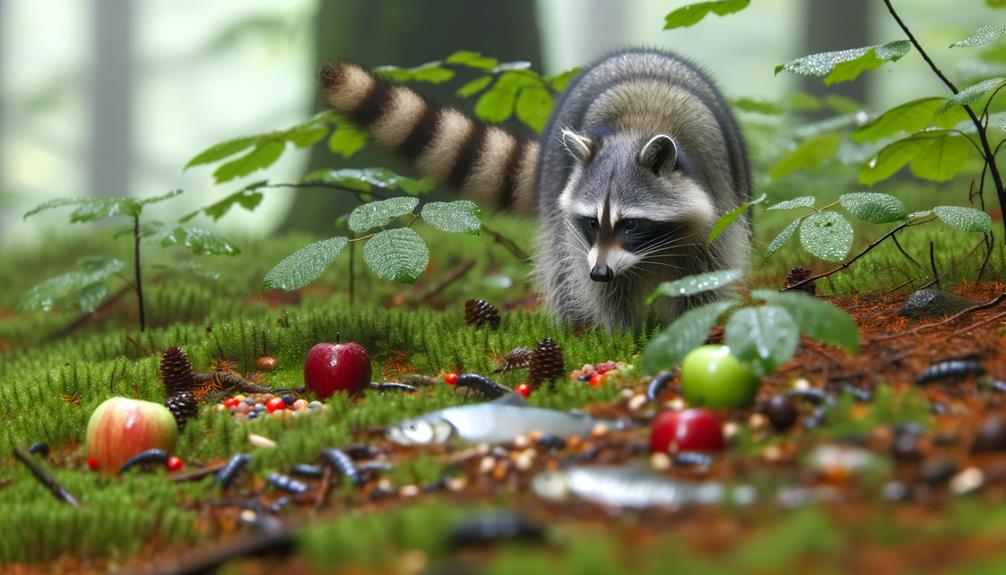
Raccoons (Procyon lotor) exhibit an omnivorous diet, consuming a diverse array of both plant and animal matter. Studies have shown that their diet includes fruits, nuts, seeds, insects, amphibians, and small mammals.
Analysis of raccoon scat has revealed that approximately 40% of their diet consists of plant material, while the remaining 60% comprises animal-based sources. This dietary flexibility allows raccoons to thrive in various habitats, from urban environments to rural woodlands.
Their foraging behavior and dietary choices are influenced by the availability of seasonal resources, but they demonstrate a marked preference for high-protein and high-fat food items when accessible. These omnivorous tendencies contribute to their ecological role as both predator and scavenger, impacting multiple trophic levels.
Seasonal Eating Habits
Seasonal variations notably influence the diet of raccoons, with distinct changes observed in their feeding patterns throughout the year.
During winter, raccoons tend to consume more plant-based food due to the scarcity of animal prey, while spring introduces a higher intake of insects and small vertebrates.
In the summer and fall, the availability of fruits and nuts becomes prominent, supplementing their omnivorous diet and preparing them for the colder months ahead.
Winter Dietary Changes
During winter, the dietary habits of raccoons exhibit significant adaptations driven by the scarcity of their typical food sources. Data indicates a marked shift towards increased consumption of animal protein, as raccoons exploit available meat sources such as small mammals, birds, and carrion. This shift is evidenced by stomach content analyses that show a higher proportion of animal matter during colder months.
Additionally, raccoons may consume more stored human food waste, which can provide necessary calories when natural resources are limited. The physiological need to build fat reserves for insulation and energy during winter further underscores the importance of high-calorie intake. Consequently, these adaptive strategies enable raccoons to maintain their metabolic functions despite the challenging winter environment.
Spring Feeding Patterns
As temperatures rise and food sources become more abundant, the spring season prompts a dietary shift characterized by a greater intake of fruits, insects, and amphibians.
Raccoons, known for their omnivorous diet, adapt their feeding patterns to exploit the seasonal surge in food availability. Studies have shown a marked increase in the consumption of berries, insects such as beetles and caterpillars, and amphibians like frogs during this time.
This shift is not merely opportunistic but also aligns with the raccoon's nutritional requirements, providing essential vitamins and proteins. This seasonal dietary adaptation underscores the raccoon's ecological flexibility and its role in maintaining balanced local ecosystems by controlling insect and amphibian populations.
Summer and Fall Foods
In the summer and fall, raccoons exhibit a notable shift towards consuming a higher proportion of nuts, fruits, and small mammals, as these food sources become more readily accessible.
Data indicates that during these seasons, raccoons increase their intake of acorns, berries, and various types of insects, capitalizing on their abundance.
A study conducted in deciduous forests documented a 35% rise in fruit consumption and a 20% increase in small mammal predation compared to spring.
This dietary flexibility allows raccoons to efficiently accumulate fat reserves for the winter months.
Additionally, their opportunistic feeding strategy ensures that they exploit the seasonal peak in food availability, which is crucial for their survival and reproductive success.
Common Food Sources
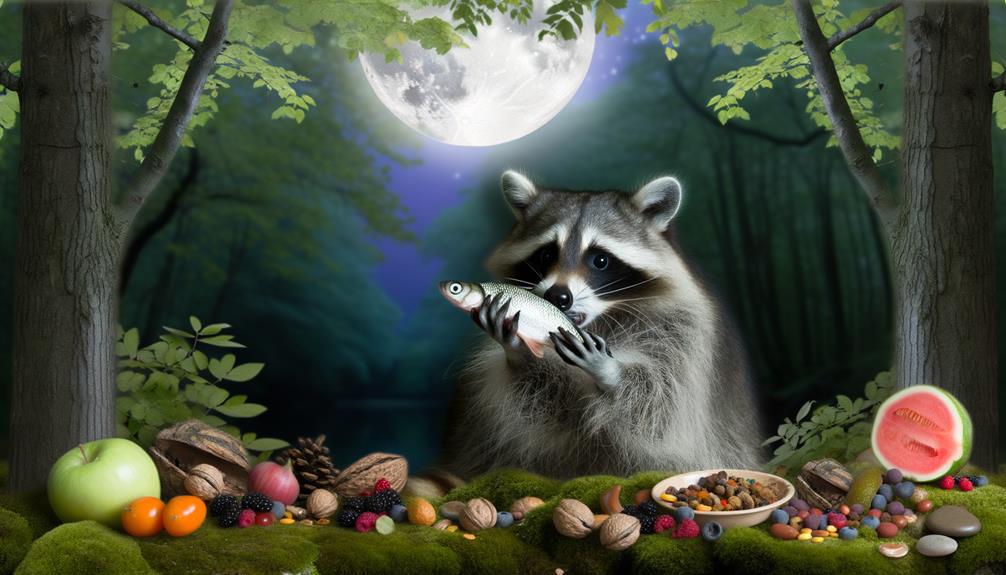
Raccoons exhibit omnivorous dietary patterns, consuming a diverse array of food sources that includes fruits, nuts, insects, small animals, and human refuse. Their broad diet is supported by their highly adaptable foraging behavior and keen sense of touch. This dietary flexibility allows raccoons to thrive in various habitats, from urban areas to forests. Quantitative data indicate significant seasonal variation in their food sources, with a marked increase in animal-based foods during warmer months.
| Food Source | Percentage of Diet | Seasonal Availability |
|---|---|---|
| Fruits | 30% | Summer, Fall |
| Nuts | 20% | Fall, Winter |
| Insects | 15% | Spring, Summer |
| Small Animals | 25% | Spring, Summer, Fall |
| Human Refuse | 10% | Year-Round |
These data underscore the raccoon's opportunistic feeding strategies, essential for their survival.
Raccoons as Omnivores
Omnivorous by nature, raccoons exhibit dietary habits that encompass both plant and animal matter, allowing them to exploit a wide range of food resources. Research indicates that raccoons consume approximately 40% animal matter and 60% plant matter, showcasing their dietary versatility.
Their animal-based diet includes insects, small mammals, and amphibians, while plant-based foods comprise fruits, nuts, and grains. Seasonal variations notably influence their food choices; for instance, raccoons consume more animal matter during spring and summer when prey is abundant, and shift to plant matter in fall and winter.
This adaptability in diet not only demonstrates their opportunistic feeding behavior but also enhances their survival in diverse habitats, from urban environments to wild forests.
Hunting Behavior
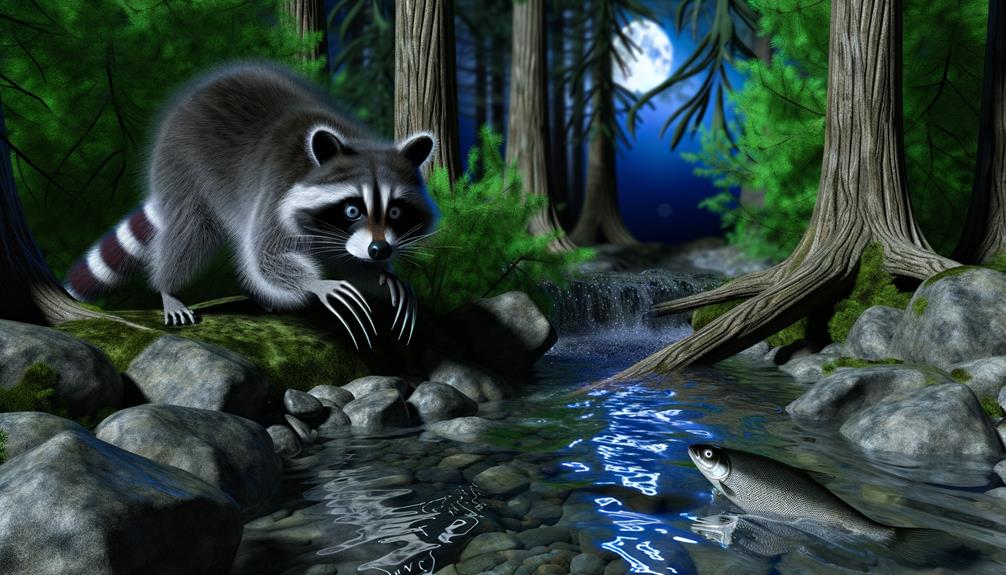
Raccoon hunting behavior demonstrates a remarkable level of adaptability and resourcefulness. This behavior is characterized by their ability to exploit a variety of prey through tactile foraging and nocturnal activity. Studies have shown that raccoons use their highly sensitive front paws to detect and capture prey, such as insects, small mammals, and crustaceans, often in aquatic environments.
Data from nocturnal field observations indicate that raccoons engage in solitary hunting, optimizing their chances of success by leveraging their keen sense of touch and night vision. Additionally, raccoons exhibit flexibility in their hunting strategies, adjusting their methods based on prey availability and environmental conditions. This behavioral plasticity allows raccoons to maintain a diverse diet, contributing to their survival in varied habitats.
Predatory Instincts
Predatory instincts in Procyon lotor can be attributed to a combination of anatomical adaptations and behavioral strategies, which collectively enhance their efficacy as opportunistic hunters. Anatomically, raccoons possess sharp claws and dexterous forepaws, enabling them to capture and manipulate prey effectively. Their acute sense of hearing and night vision facilitate nocturnal hunting, while their strong olfactory senses aid in detecting prey.
Behaviorally, raccoons exhibit remarkable problem-solving skills and a high level of curiosity, allowing them to exploit various food sources. Studies have shown that raccoons will prey on small mammals, birds, amphibians, and invertebrates, demonstrating their versatility. This adaptability underscores their predatory capabilities and their ability to thrive in diverse environments, from urban areas to dense forests.
Scavenging Tendencies
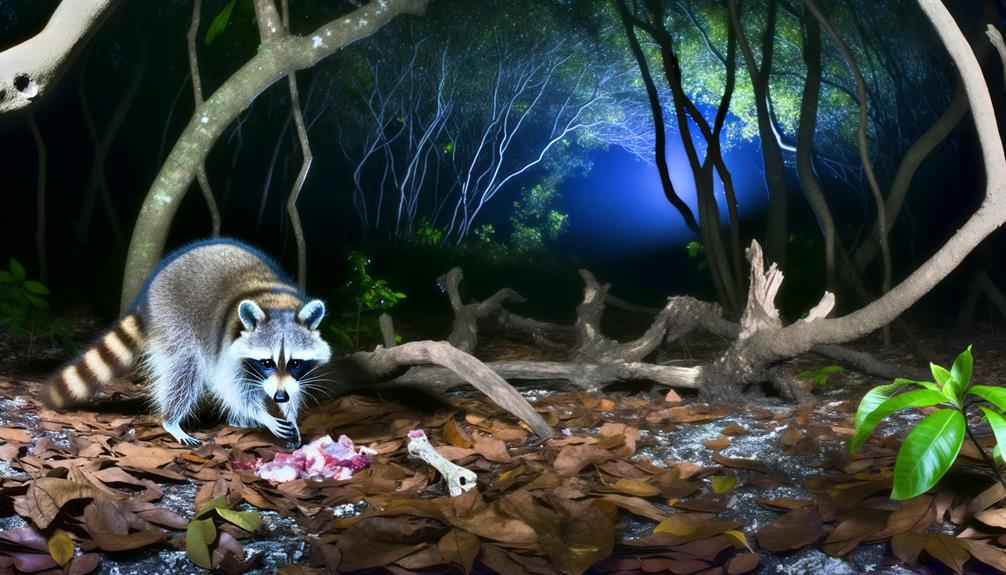
In addition to their predatory capabilities, Procyon lotor exhibits significant scavenging tendencies that further diversify their dietary habits. These tendencies are well-documented through various observational studies and data collection efforts. Scavenging allows raccoons to exploit a wide range of food sources, thereby increasing their adaptability and survival rate.
Especially, their scavenging behaviors include:
- Urban Foraging: Raccoons frequently scavenge in urban areas, often rummaging through trash bins for discarded food.
- Carrion Consumption: They consume animal carcasses, which provides an essential food source, particularly during scarce periods.
- Leftover Feeds: In rural settings, raccoons scavenge on leftover pet and livestock feeds.
- Natural Foraging: They also scavenge in natural habitats, utilizing fallen fruits and nuts.
These behaviors highlight their opportunistic feeding strategies.
Impact of Habitat
The habitat of Procyon lotor plays an essential role in shaping its dietary habits and overall behavioral ecology. Urban environments provide raccoons with easy access to anthropogenic food sources, including meat from garbage and pet food, thereby increasing their dietary diversity.
Conversely, in rural or forested areas, raccoons rely more on natural food sources such as insects, amphibians, and small mammals. Studies indicate that raccoons in coastal regions often consume marine organisms, including crustaceans and fish.
Seasonal variations also influence diet; for instance, raccoons may consume more plant material in summer and fall when fruits and nuts are abundant. Habitat-specific food availability directly impacts their role as omnivores, driving adaptive foraging strategies to maximize nutritional intake.
Nutritional Needs
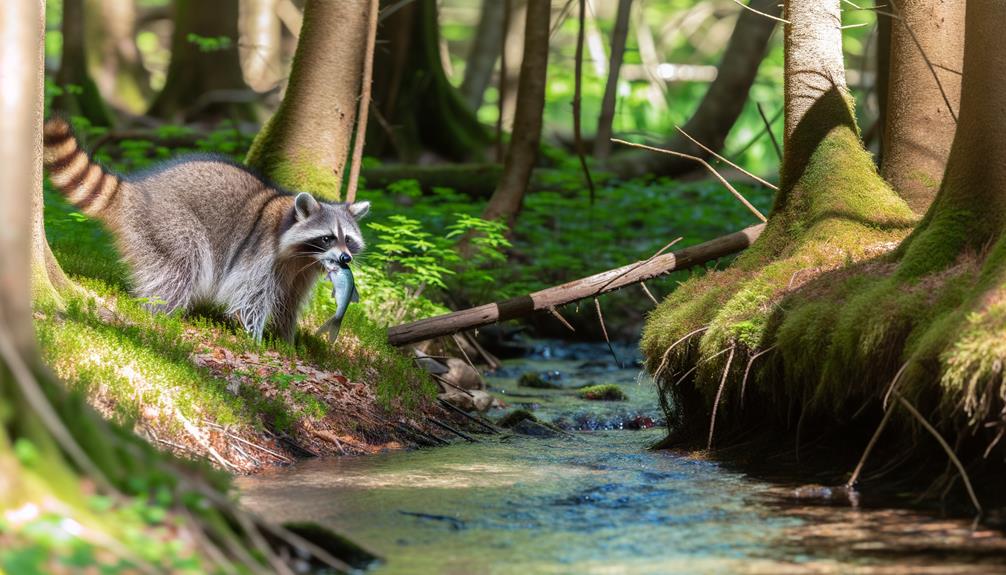
Understanding the nutritional needs of raccoons requires an examination of their protein requirements and dietary variety. Studies indicate that protein intake is essential for their growth, reproduction, and overall health.
Additionally, raccoons exhibit omnivorous feeding behaviors, consuming a diverse range of foods to meet their energy and nutrient demands.
Protein Requirements
Raccoons require a diet containing approximately 20-30% protein to support their metabolic functions and overall health. Protein is important for:
- Tissue Repair and Growth: Proteins are fundamental building blocks for cellular repair and growth, essential for maintaining muscle mass and organ function.
- Enzymatic Functions: Many enzymes, which facilitate biochemical reactions, are proteins, making them necessary for metabolic processes.
- Immune System Maintenance: Proteins are crucial for synthesizing antibodies and other immune components, fortifying the raccoon's defense mechanisms.
- Energy Production: While fats and carbohydrates are primary energy sources, proteins can be metabolized for energy, especially during periods of scarcity.
These protein requirements underscore the significance of a balanced diet in ensuring the physiological well-being of raccoons.
Dietary Variety
Incorporating a diverse array of foods into their diet is crucial to meet the extensive nutritional requirements of raccoons. Raccoons are omnivorous creatures whose diet must include a balance of proteins, fats, carbohydrates, vitamins, and minerals. A varied diet ensures that raccoons obtain all the necessary nutrients to maintain peak health.
| Nutrient | Source | Importance |
|---|---|---|
| Protein | Insects, fish, small mammals | Muscle development, repair |
| Fat | Nuts, seeds, animal fat | Energy storage, cell function |
| Carbohydrates | Fruits, vegetables | Immediate energy supply |
| Vitamins | Berries, leafy greens | Immune function, metabolism |
| Minerals | Soil, water, bones | Bone health, enzyme function |
This diverse dietary intake supports their physiological needs and enhances their survival in different habitats.
Interaction With Humans
The interaction between raccoons and humans has been extensively documented, revealing both the challenges and adaptations that arise from their cohabitation in urban environments. Research indicates several significant aspects of this interaction:
- Habitat Encroachment: Urban development has led to raccoons adapting to human-dominated landscapes, utilizing resources like garbage bins and pet food.
- Disease Transmission: Raccoons are vectors for diseases such as rabies and leptospirosis, posing health risks to humans and pets.
- Behavioral Adaptation: Raccoons exhibit increased nocturnal activity and altered foraging behavior to avoid human interaction.
- Conflict and Management: Strategies such as secure trash containers and wildlife exclusion practices are recommended to mitigate human-raccoon conflicts.
Understanding these factors is essential for developing effective coexistence strategies.
Conclusion
In summation, raccoons exhibit a diverse and adaptable diet, consuming both plant and animal matter, reflective of their omnivorous nature.
Their eating habits shift with the seasons, influenced by the availability of food sources.
As opportunistic feeders, raccoons display a balance of hunting prowess and scavenging behavior, akin to nature's versatile foragers.
The intricate interplay between habitat and nutritional needs underscores the complexity of their dietary patterns, highlighting the raccoon's role in various ecosystems.




